One of the most magical places you can visit in Scotland is Fingal’s Cave on the Isle of Staffa.
It can be found on an uninhabited island that is made up of thousands of basalt columns formed millions of years ago.
This wild and desolate sea cave has attracted many famous visitors, including artists, musicians, poets and royalty over time.
Although remote, it’s very easy to plan a visit to Staffa. I booked an organised day tour from Oban but you can also visit self-guided.
It’s one of my favourite memories from Scotland as it feels like you’ve entered another world entirely.
Here is how to visit Fingal’s Cave on the Isle of Staffa, with helpful travel tips.
Note: cruises are running, but the Staffa jetty is closed for boat landings until June 2025 for essential maintenance.
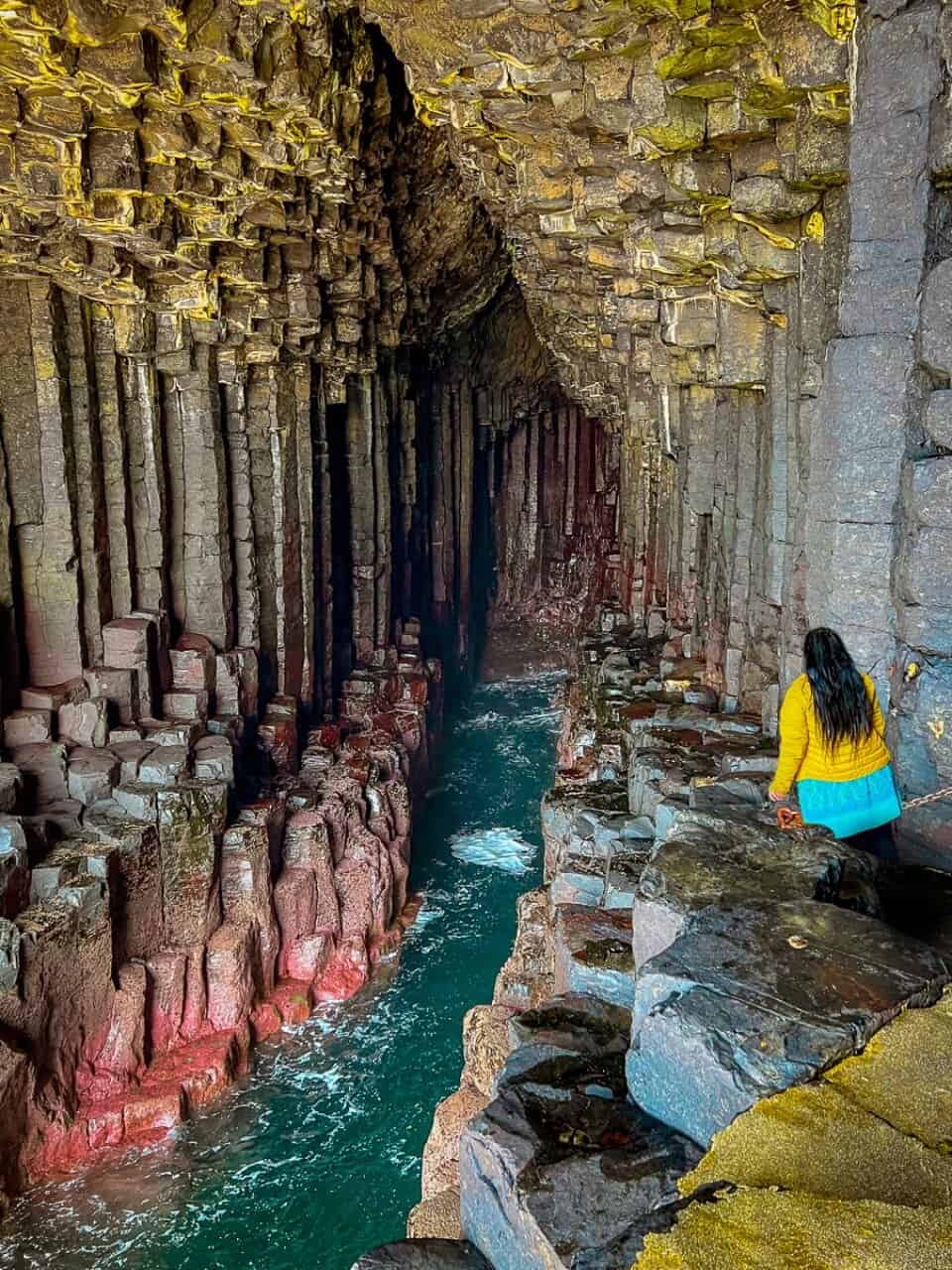
Why is Fingal’s Cave so special?
The Isle of Staffa is a tiny island off the West Coast of Scotland that was formed by volcanic activity over 60 million years ago.
The mysterious uninhabited island is often nicknamed ‘Pillar Island’ as it is made up of thousands of hexagonal basalt columns formed by lava.
There are many natural sea caves made of these columns on Staffa, but the most famous is Fingal’s Cave or An Uamh Binn.
The name comes from a legendary Irish warrior called Finn McCool or Fingal. He famously protected the Hebrides from Viking raids in 3AD.
The reason why this particular cave is so unique is due to its size which many call the ‘Cathedral of the Sea’ or ‘Cave of Melody’.
It also has a natural walkway that allows visitors to walk straight inside, and many famous figures have explored Fingal’s Cave over the centuries.

Fun fact: Fingal’s Cave has the same origins as the Giant’s Causeway in Northern Ireland!

Royalty, Art, Poetry, & Music
Many influential figures have been drawn to this wild, evocative sea cave over the centuries.
The royal couple Queen Victoria and Prince Albert visited the cave and island in 1847.
Famous poets and writers such as Alfred Tennyson, John Keats, Robert Louis Stevenson and Sir Walter Scott were all inspired by its nature.
J. M. W Turner immortalised the cave in his portrait “Staffa, Fingal’s Cave” in 1832.
Perhaps the most famous visitor of all is the composer Felix Mendelssohn, who visited in 1829.
Although he had a terrible crossing with seasickness, the cave made a lasting impression on him.
A year later, he composed the haunting melody of “Hebrides Overture”.
Today, it’s very easy to follow in their footsteps and discover the magic of Staffa for yourself!

How to visit Fingal’s Cave on the Isle of Staffa
Fingal’s Cave can be found on the uninhabited Isle of Staffa in the Inner Hebrides of Argyll and Bute.
It’s a small island out at sea, so you can only access it by boat from ports on the Isle of Mull and the Isle of Iona.
You can easily take your car on one of the CalMac ferries from Oban to Craignure (Mull) and then drive to Fionnphort for the cruise.
The ferry ride from Oban to Mull takes around 45 minutes, and then it’s an hour’s drive to Fionnphort.
The boat ride to Staffa and Fingal’s Cave will be 30-45 minutes each way, depending on the wind and tide.
You can book your boat trips through Staffa Tours or Staffa Trips for £40 return from Fionnphort. It will be £85 Tobermory.

Why not book a guided tour?
If you want to take the hassle out of planning a visit to the Isle of Staffa, why not book a Three Isles Tour with West Coast Tours?
The trip departs from Oban and takes you to Mull, Iona and Staffa in one magical day!
This is what I did and I had the best time. It’s still one of my favourite day trips in Scotland I’ve taken to date.
The only thing to note is that it’s a very long trip (10 hours). However, it’s worth it to experience a slice of the Inner Hebrides without the fuss!


Travelling from Oban to Fionnphort
Whether you decide to take an organised tour or not, you will need to travel from Oban to the Isle of Mull via ferry to visit the Isle of Staffa.
My guided tour included a passenger ticket I had to pick up from their tour office in Oban beforehand.
It’s good to know that you travel on this ferry without a guide/group. So, make sure to board on time; it won’t wait!
I always love a CalMac ferry journey as the ships are spacious with lots of seating and outdoor spaces.
There’s also a great café where you can enjoy coffee or breakfast with panoramic views.

Once our ferry arrived at the port of Craignure on Mull, West Coast Tour coaches were already waiting for us at the terminal.
So, I hopped on board with my group and was brimming with excitement to start my Hebrides adventure.
I’m going to be honest: You won’t see much of Mull on the Three Isles day trip.
You drive straight through the island for an hour or so to reach Fionnphort.

This is where all the boats leave to take you to the Isle of Staffa or the Isle of Iona.
However, you get to see some beautiful views along the way, including Ben More, Mull’s highest point.
Our driver also had a funny but informative commentary about the island to entertain us, including bits on Paul McCartney’s Mull of Kintyre.

The boat ride from Fionnphort to Staffa
Like clockwork, as soon as our coach arrived in Fionnphort we immediately boarded the boat to Fingal’s Cave on the Isle of Staffa.
Although it was raining on our coach journey through Mull, the sun decided to come out, so we had amazing weather for our cruise!
As the sun was shining, the water looked so clear and turquoise. It was such a transformation.

There’s also lots of wildlife to spot in this area. I saw many birds such as gannets and guillemots.
Seals were sunbathing on the rocks, and we even saw dolphins at one point. Unfortunately, they were too quick for my camera.
Although the water did look pretty still, and the waves were calm, the boat ride was quite choppy in parts.

The commentary to distract you was excellent, though and told you about Fingal’s Cave, how it was formed and the numerous famous visitors.
When you are in front of the sea cave on the water, the boat plays a piece from Mendelssohn’s “Hebrides Overture”.
He wrote the symphony after his visit in 1829, and it gave me chills to hear it playing here.

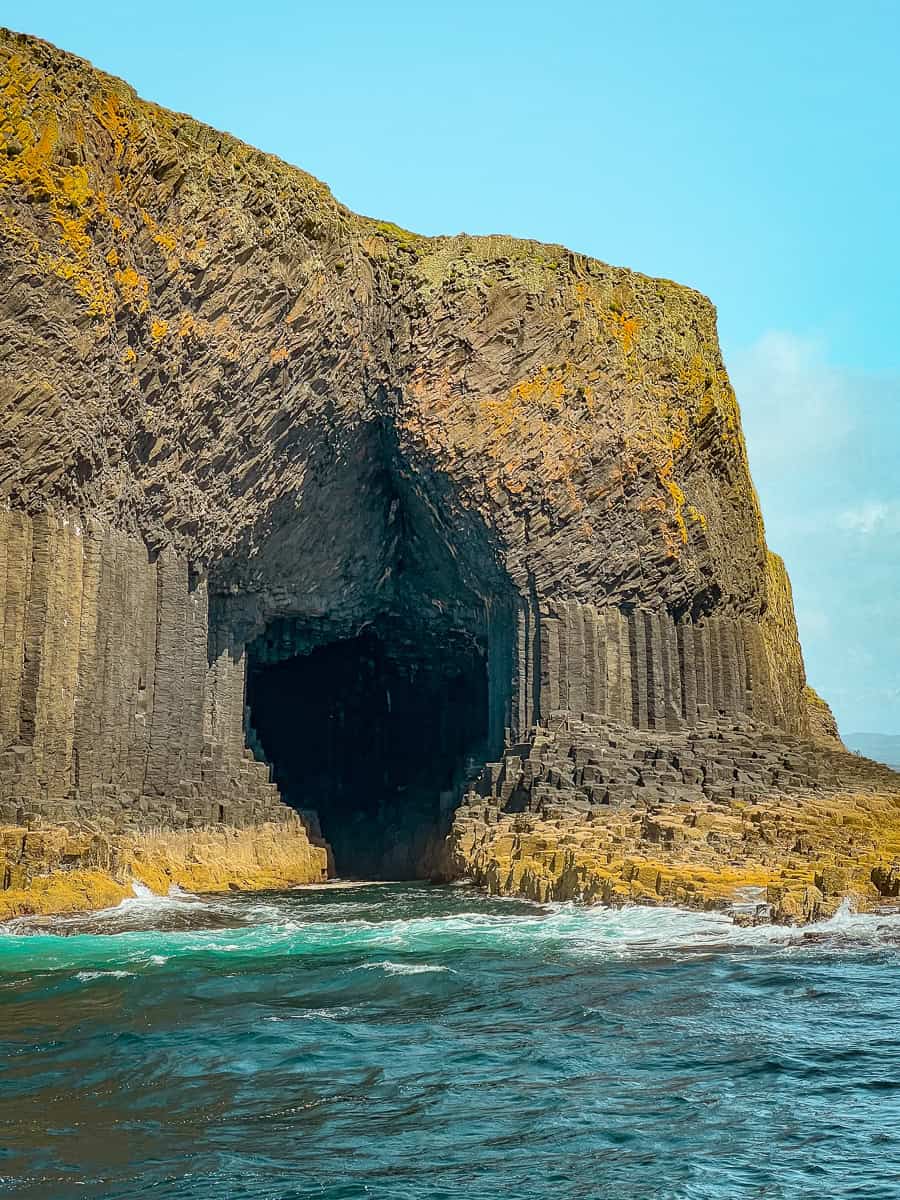
Landing on the Isle of Staffa
Another reason why I was so thankful for the good weather on our trip was because our boat could safely land on the Isle of Staffa.
Not every boat trip can do this as it can be too dangerous in inclement weather. The Staffa jetty is also quite small.
Our boat was also one of the first to arrive on the island for the day, so I got some clean photos.
Traditionally, the island can have lots of people scattered all over the cave, so I felt very thankful.
I was so excited to get off and explore this remote and mysterious natural island made up of thousands of basalt columns!
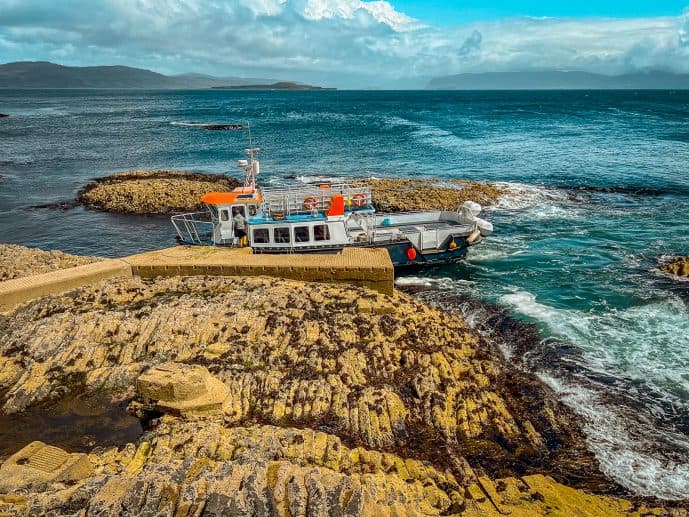
Walking to Fingal’s Cave
As soon as the boat lands at the Staffa jetty, most visitors make a beeline to visit Fingal’s Cave.
The landscape of the island is extraordinary, with thousands of basalt columns that emerge from the sea in all shapes and formations.
You’ll be walking on top of these hexagonal columns over a natural causeway to visit the sea cave.
It wasn’t overly difficult. I found it quite fun, but I would still watch your step as the columns are uneven.

Make sure to grab onto the handrail that’s been installed to assist you. Some of the columns can be slippery due to the weather and tide.
The walk doesn’t take a long time (5 minutes at most), but you may have to queue to get inside the cave as the path inside is narrow.
It’s a little frustrating as you only have a limited time on the island but don’t be put off as it’s worth waiting for!


Can you go inside Fingal’s Cave?
Yes, you can. An amazing feature of the legendary Fingal’s Cave is the natural walkway allowing you to step inside.
You climb up the hexagonal columns to a raised viewing platform that allows a better view.
I was in awe of this cave with its many dark columns, and the loud noise of waves crashing against the rocks echoed through the chamber.
The sound was almost like a melody, with the columns as organ pipes. You can see why Mendelssohn was inspired to write his overture here.
The small platform at the top of the cave also makes a great photo opportunity. Just bring some patience as it’s often crowded.
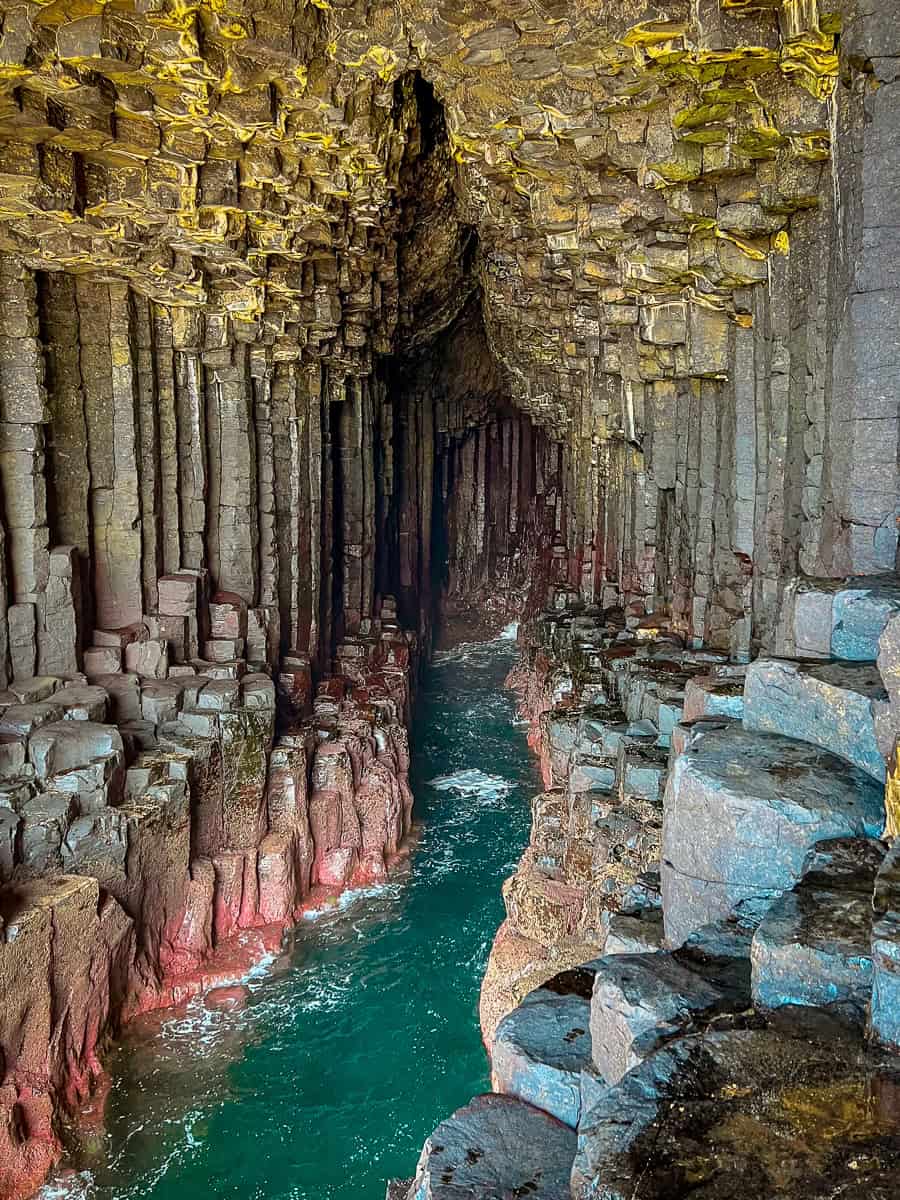
Other things to do on the Isle of Staffa
After you’ve explored Fingal’s Cave, you can head back to the jetty and climb the steep steps over Clamshell Cave to explore more of the island.
I’m not going to lie; the metal staircases are very tall, and the heights can be intimidating.
Luckily, the views from the top make up for it. From this vantage point, you can see the natural causeway in all its glory.
Thousands of hexagonal basalt columns have formed into quirky shapes from wind and tide, it’s mind-blowing.

The island is only half a mile long and a quarter of a mile wide. You could easily get around the whole thing if you have a couple of hours.
On the west side of Staffa, you can find Boat Cave or McKinnon’s Cave. But, you may not have enough time to explore those on your visit.
I recommend following the well-trodden path on the east side of the island anti-clockwise for ten minutes to search for Isle of Staffa puffins.

Isle of Staffa puffins
Another highlight of visiting the Isle of Staffa is seeing all the marvellous puffins that migrate here!
They arrive on the island around April and leave in early August after nesting.
I visited in mid-July and was able to see them up close as they were bringing food ashore to their chicks.
You can sit down and relax on the grass, and they will come straight to you. They weren’t skittish and seemed to love all the attention.

According to our guide, they gather close to humans as protection against predatory birds.
It was marvellous as I could appreciate their bright colours and orange beaks up close, even without binoculars.
Just be careful not to get too close to their nests. It’s very easy to trample on them and cause damage.

Exploring the Isle of Iona
All too quickly for my liking, our time on Staffa came to an end, so I forced my eyes away from the puffins and quickly walked back to the boat.
I could have spent hours birdwatching. It was such a lovely day, and the unique landscape was bewitching!
To protect the island, most groups only have around an hour or so on Staffa to allow for more visitors.
So, our group boarded our boat and cruised over to the magical Isle of Iona, one of my favourite islands in Scotland.

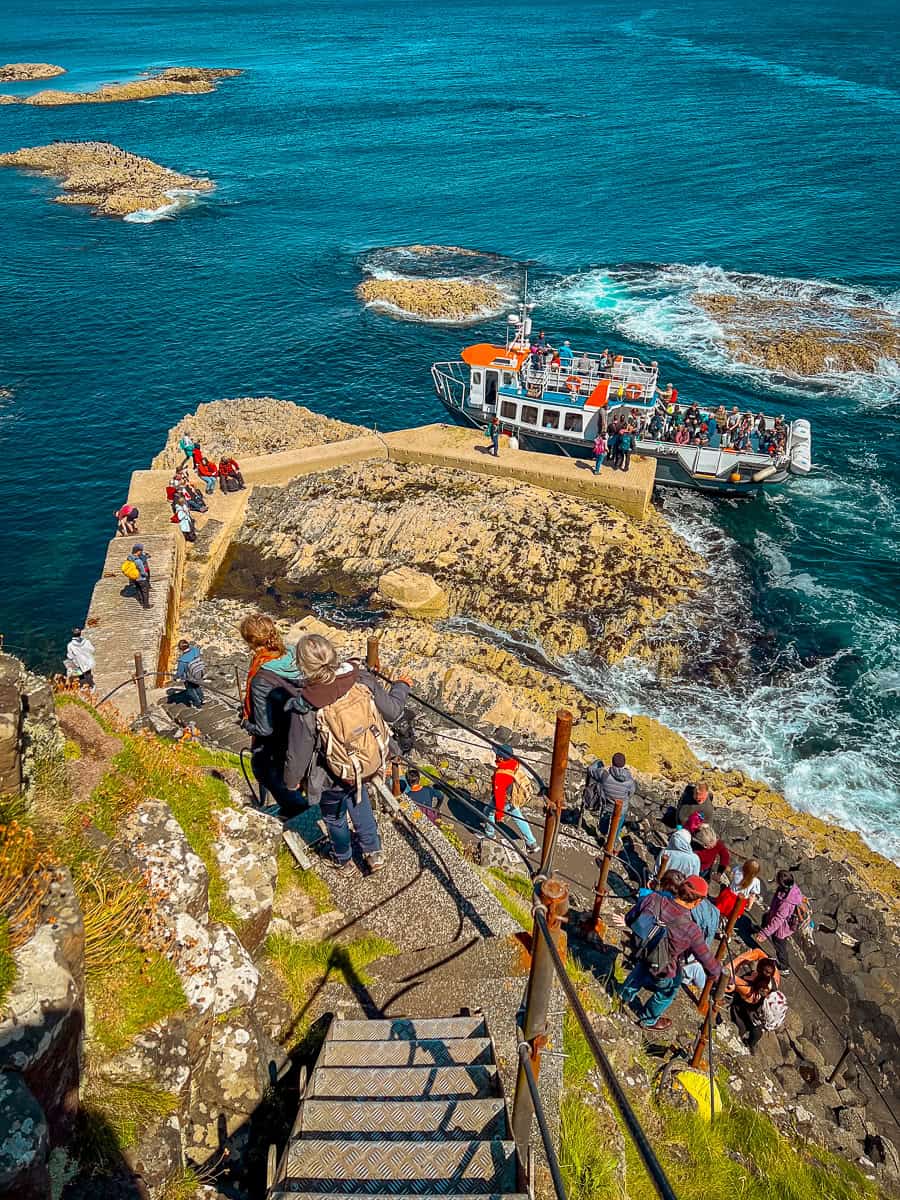
Iona is known for its white sands and crystal clear blue waters that make it feel like you’re in the Caribbean…if you can ignore the chill!
It’s also famous for being the birthplace of Christianity in Scotland since St. Colomba arrived on the island in 563 AD.
It then became a resting place of Celtic Kings. Years ago, many chieftains’ final wish was for their body to make a voyage to Iona for burial.
You can learn more about this in the historic Iona Abbey & Nunnery, the main attraction on the island. You can pre-book your tickets here.

I didn’t prebook but was happy to discover my English Heritage membership allowed free entry to all Historic Scotland sites.
We had around two hours to explore Iona but most of my time was spent learning all the history in the Abbey Museum as it was so fascinating.
I took a packed lunch, knowing that the facilities on the island were limited.
But, I did buy a coffee in the St Columba Larder that has a deli serving light bites and drinks.
Finally, I took a leisurely stroll towards the port to step on the white sand and paddle in the crystal clear water!

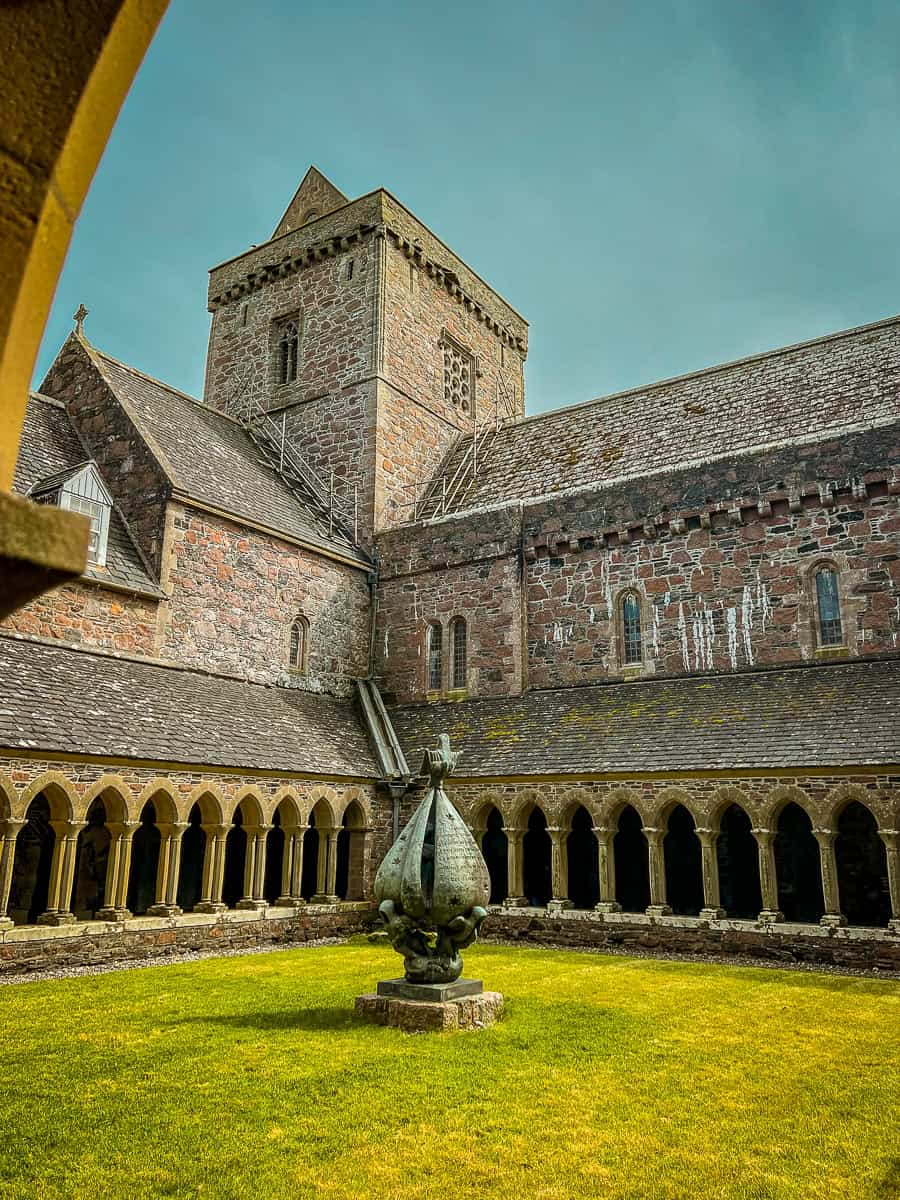
Journey back to Mull and Oban
All good things must come to an end, and our group finally said goodbye to the beautiful Iona.
One day, I’d love to stay on the island as it’s such a special place with many more pretty beaches to find.
We boarded the CalMac ferry back to Fionnphort in Mull, where our coach was waiting for us.

We then slowly drove back through Mull to Craignure to catch our ferry to Oban.
As it was getting late, I treated myself to Fish & Chips for dinner on the CalMac ferry. We then arrived back on the mainland around 8 pm.
It was a long and tiring day, to be sure, but so worth it to see the magical Fingal’s Cave! It’s a day I’ll never forget.

Is Fingal’s Cave worth visiting?
Yes, I think that Fingal’s Cave on the Isle of Staffa is a place you must see in your lifetime.
There’s something so magical about this wild and windswept isle at sea.
The trip appeals to every interest as there is history, geography, nature, wildlife and adventure along with endless photo opportunities.
I’ve been dreaming of visiting this legendary sea cave for years and so my trip was a wish come true.
It’s also much easier than you would think to plan a visit. So, make sure to add the Isle of Staffa to your Scotland bucket list!
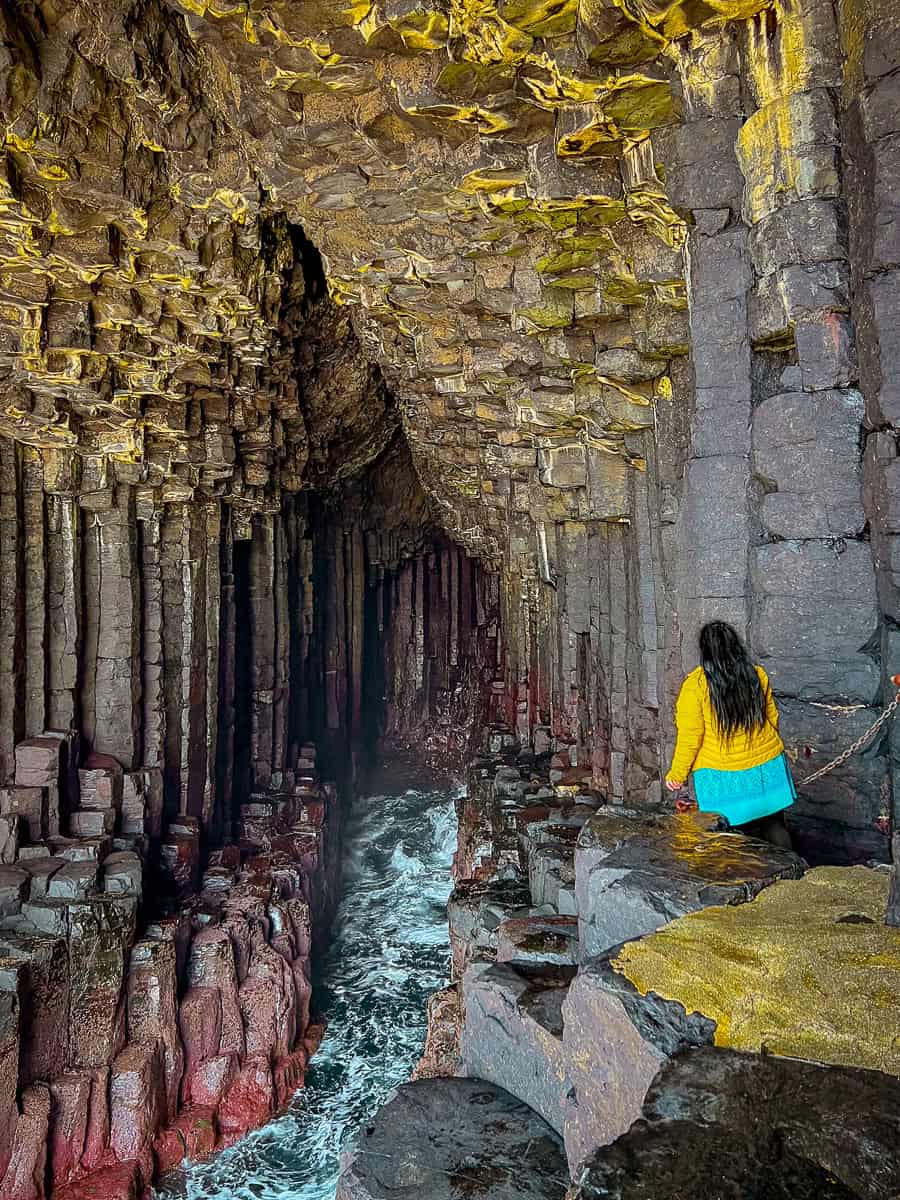
Important tips for your visit
- Dress for the weather – Scotland often experiences four seasons in one day, and the wind can be chilly even in summer. Staffa is also largely exposed to the elements. Make sure to bring layers, waterproofs or sun protection.
- Wear sensible shoes – The basalt columns on the Isle of Staffa can get slippery, and you’ll be traversing many steps and uneven ground.
- Bring water and snacks – The ferries have a restaurant, but there is no café on Staffa, and Iona has limited facilities. It’s highly recommended to bring lunch, drinks and snacks with you.

- Is there a toilet on Staffa? As an uninhabited island, there are no toilets on Staffa. Use the loo on the boat before you disembark!
- Seasickness – the ferry rides can be rough, even on a clear day with calm water. If you suffer from seasickness, have your preventative medication or rituals prepared.
- Accessibility – Staffa can be difficult to explore if you require accessibility. It’s made up of basalt columns, steep stairs and uneven terrain. You do have the option to stay on the boat. If in doubt, contact the tour operator before you book.
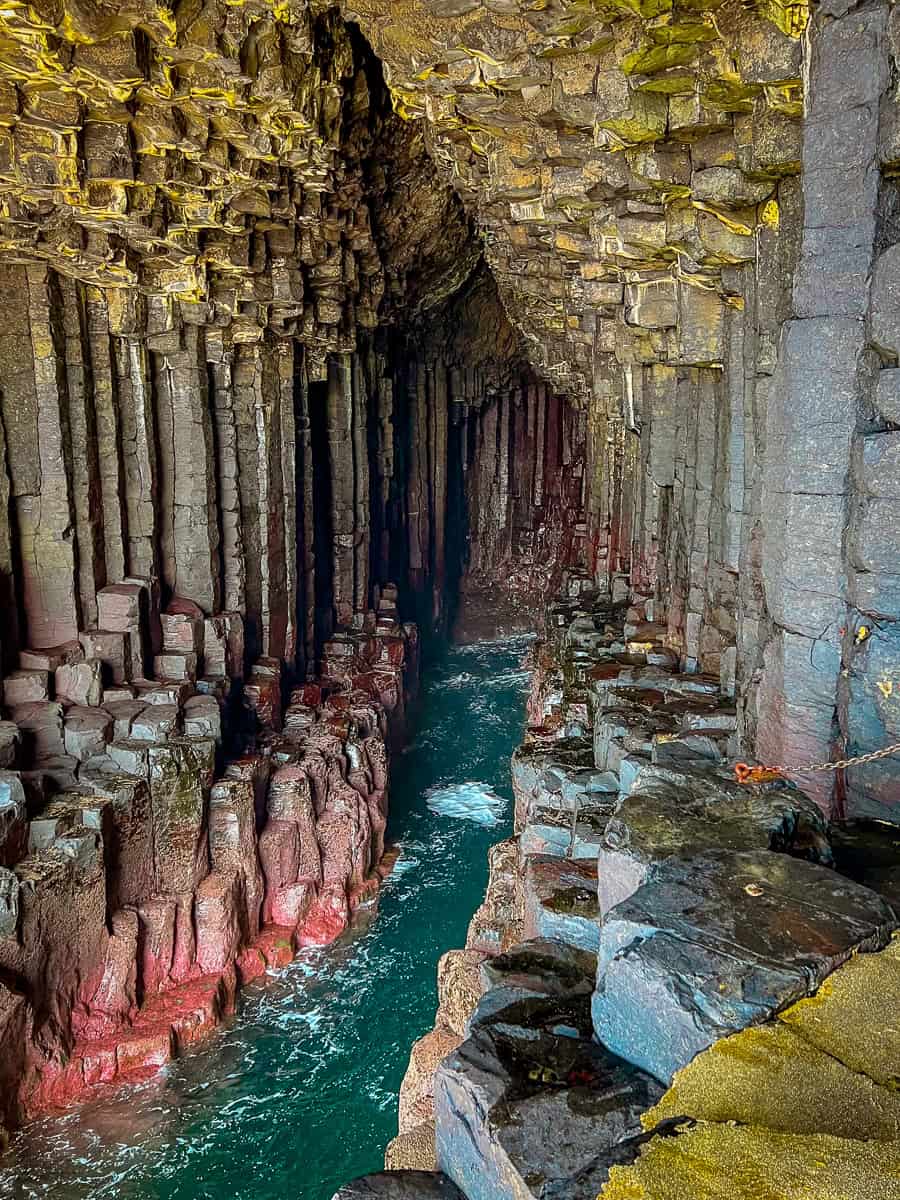
Read more of my Scotland travel guides
How to visit the Green Loch Aviemore
Visiting the Puck’s Glen Fairy trail
How to ride the Hogwarts Express in Scotland
Harry Potter filming locations in Scotland
Edinburgh Harry Potter filming locations
How to Find Dumbledore’s Grave
How to see Eilean Donan for free
How to visit the Balmoral Pyramid
Visit the Pink House on Loch Glass
A complete guide for the Steall Falls walk
How to find the Corpach Shipwreck
How to find the Kilchurn Castle viewpoint
Magical Dunrobin Castle in Scotland
How to visit the Kelpies in Falkirk
How to visit the Wee White House in Glen Coe
How to visit the Glenfinnan Viaduct Viewpoint
Outlander locations you can visit in Scotland
How to visit Lallybroch from Outlander

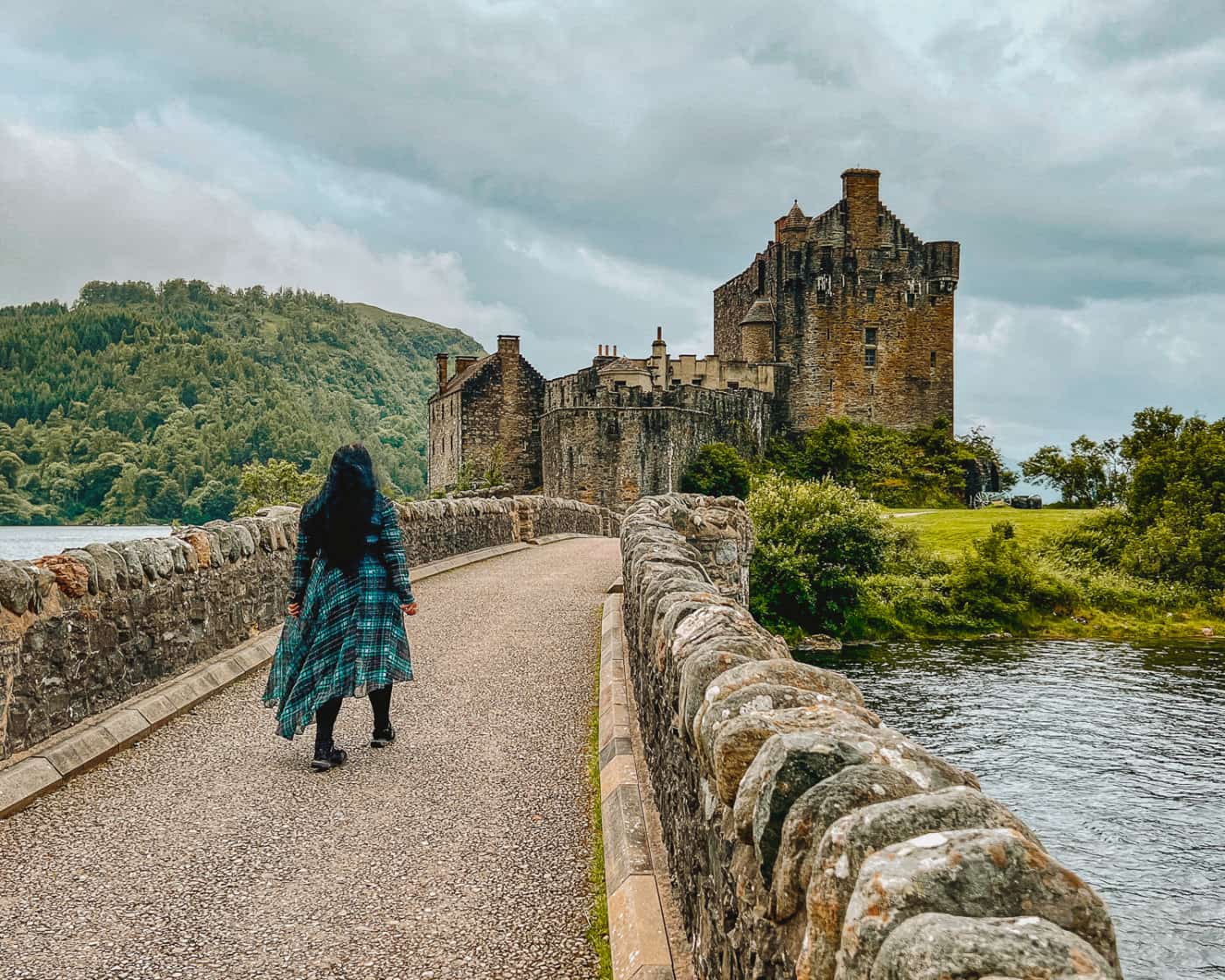
Save How to Visit Fingal’s Cave for later!


